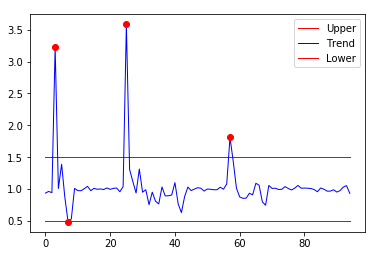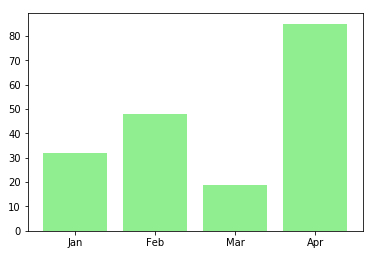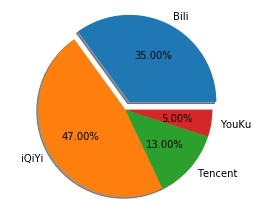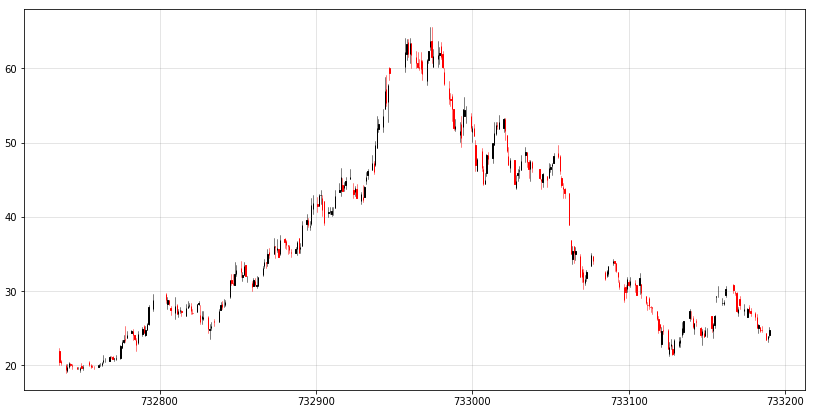折线图示例
#!/usr/bin/python2.7
import numpy as np
from matplotlib import pyplot as plt
from dbtools import raw_data
from utils import moving_sum
def moving_sum(array, window):
if type(array) is not np.ndarray:
raise TypeError('Expected one dimensional numpy array.')
remainder = array.size % window
if 0 != remainder:
array = array[remainder:]
array = array.reshape((array.size/window,window))
sum_arr = np.sum(array,axis=1)
return sum_arr
def run():
window = 3
y_lst = raw_data('2018-08-03 00:00:00', length=3600*24)
raw_arr = np.array(y_lst)
sum_arr = moving_sum(raw_arr,window)
res = np.true_divide(sum_arr[1:],sum_arr[:-1])
threshold = 0.5
upper = np.array([1+threshold]*res.size)
lower = np.array([1-threshold]*res.size)
plt.plot(upper,lw=1,color='red',label='Upper')
plt.plot(res,lw=1,color='blue',label='Trend')
plt.plot(lower,lw=1,color='red',label='Lower')
r_idx = np.argwhere(np.abs(res-1) > 0.5)
plt.plot(r_idx, res[r_idx], 'ro')
plt.legend()
plt.show()
return (r_idx,res[r_idx])

画布和子图
import numpy as np
import matplotlib.pyplot as plt
fig = plt.figure(figsize=[10,8])
ax1 = fig.add_subplot(2,1,1)
x1 = np.linspace(0.1,10,99,endpoint = False)
y1 = np.log(x1)
ax1.plot(x1,y1)
ax1.set_title('Logarithmic function')
x2 = np.linspace(0, 5, num = 100)
y2 = np.e**x2
ax2 = fig.add_subplot(2,1,2)
ax2.plot(x2,y2)
ax2.set_title('Exponential function')
plt.subplots_adjust(hspace =0.2)
fig.show()

柱状图
import numpy as np
import matplotlib.pyplot as plt
data = [32,48,19,85]
labels = ['Jan','Feb','Mar','Apr']
plt.bar(np.arange(len(data)),data,color='lightgreen')
plt.xticks(np.arange(len(data)),labels)
plt.show()

饼状图
import numpy as np
import matplotlib.pyplot as plt
data = [35,47,13,5]
labels = ['Bili','iQiYi','Tencent','YouKu']
plt.pie(data,labels=labels,autopct="%.2f%%",explode=[0.1,0,0,0],shadow=True)
plt.show()

K线图


1 pip3.6 install https://github.com/matplotlib/mpl_finance/archive/master.zip
2
3 from mpl_finance import candlestick_ochl
matplotlib.finance has been deprecated

1 # https://github.com/Gypsying/iPython/blob/master/601318.csv
2
3 In [2]: import pandas as pd
4
5 In [3]: df = pd.read_csv('601318.csv', index_col='date', parse_dates=['date'])
6
7 In [4]: df.head()
8 Out[4]:
9 Unnamed: 0 open close high low volume code
10 date
11 2007-03-01 0 21.878 20.473 22.302 20.040 1977633.51 601318
12 2007-03-02 1 20.565 20.307 20.758 20.075 425048.32 601318
13 2007-03-05 2 20.119 19.419 20.202 19.047 419196.74 601318
14 2007-03-06 3 19.253 19.800 20.128 19.143 297727.88 601318
15 2007-03-07 4 19.817 20.338 20.522 19.651 287463.78 601318
16
17 In [5]: from matplotlib.dates import date2num
18
19 In [6]: df['time'] = date2num(df.index.to_pydatetime())
20
21 In [7]: df.head()
22 Out[7]:
23 Unnamed: 0 open close high low volume code time
24 date
25 2007-03-01 0 21.878 20.473 22.302 20.040 1977633.51 601318 732736.0
26 2007-03-02 1 20.565 20.307 20.758 20.075 425048.32 601318 732737.0
27 2007-03-05 2 20.119 19.419 20.202 19.047 419196.74 601318 732740.0
28 2007-03-06 3 19.253 19.800 20.128 19.143 297727.88 601318 732741.0
29 2007-03-07 4 19.817 20.338 20.522 19.651 287463.78 601318 732742.0
30
31 In [8]: df.shape
32 Out[8]: (2563, 8)
33
34 In [9]: df.size
35 Out[9]: 20504
36
37 In [10]: 2563*8
38 Out[10]: 20504
39
40 In [11]:
数据源
import numpy as np
import pandas as pd
from matplotlib.dates import date2num
from mpl_finance import candlestick_ochl
# 构建 candlestick_ochl 的sequence of (time, open, close, high, low, ...)
df = pd.read_csv('601318.csv', index_col='date', parse_dates=['date'])
# time must be in float days format - see date2num
df['time'] = date2num(df.index.to_pydatetime())
# 原始数据比较多,截取一部分做展示
df = df.iloc[:300,:]
arr = df[['time','open','close','high','low']].values
fig = plt.figure(figsize=[14,7])
ax = fig.add_subplot(1,1,1)
candlestick_ochl(ax,arr)
plt.grid(True, which='major', c='gray', ls='-', lw=1, alpha=0.2)
fig.show()








